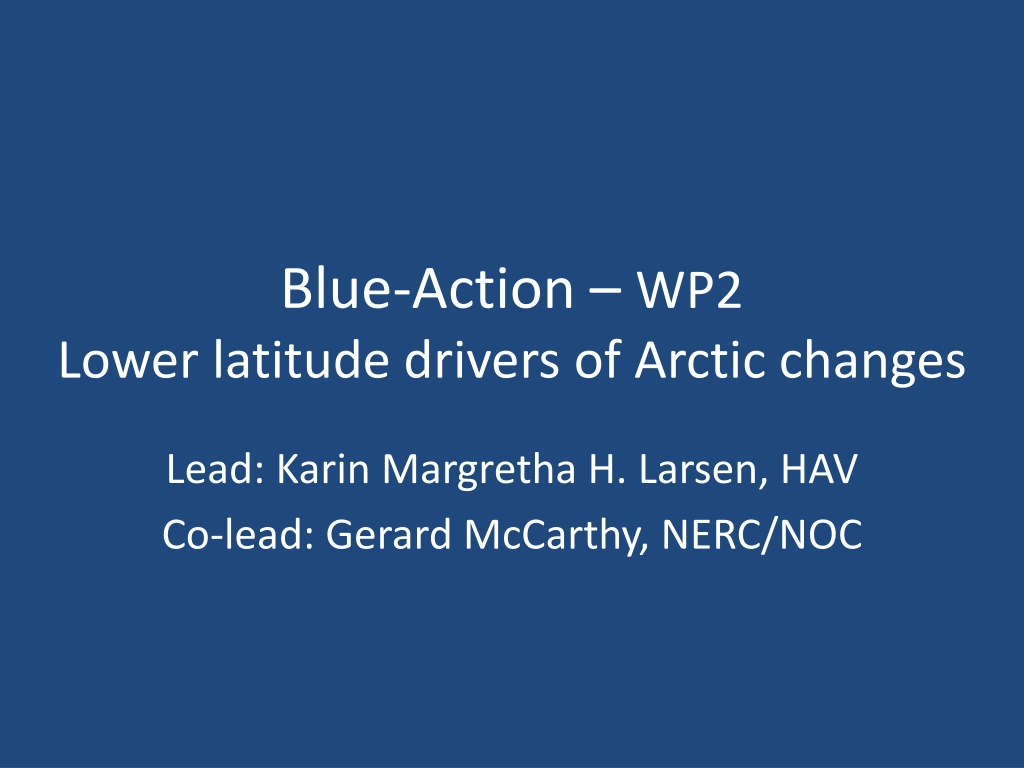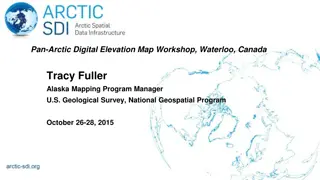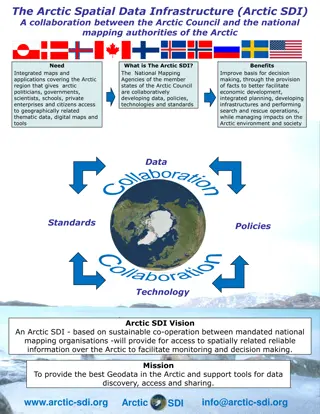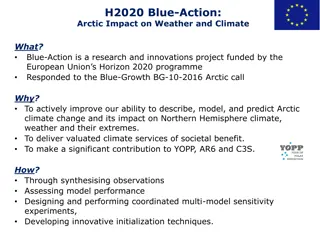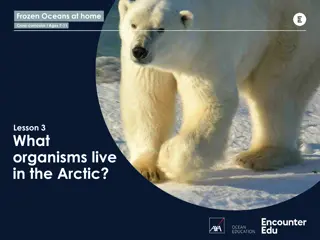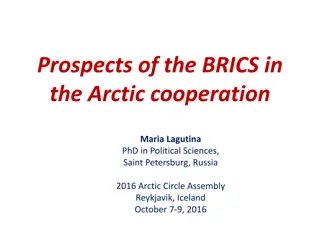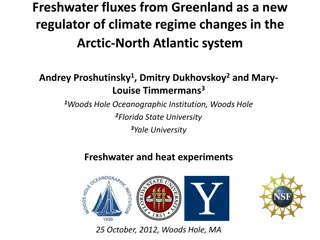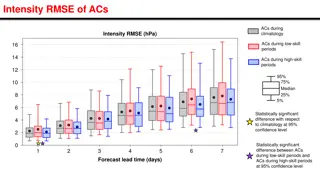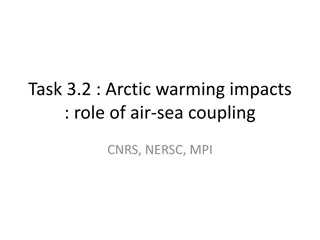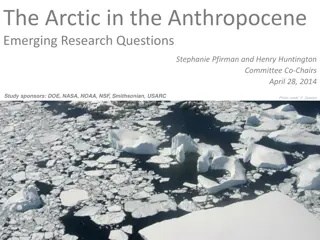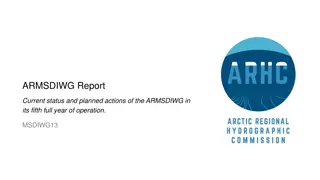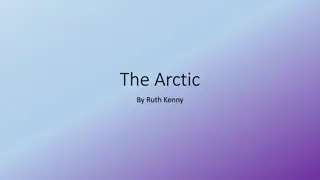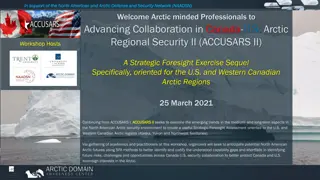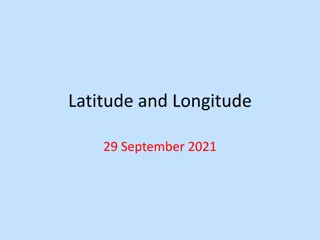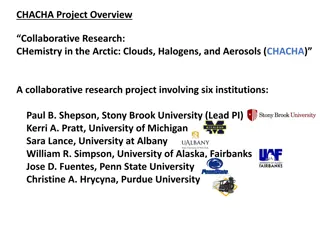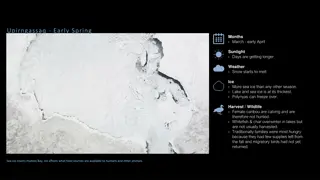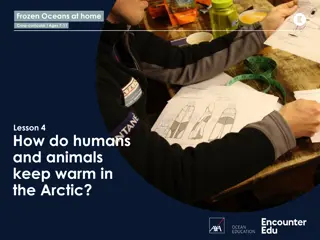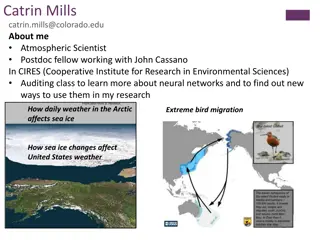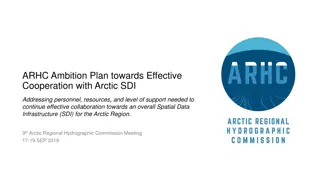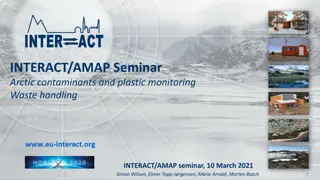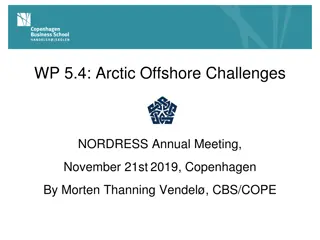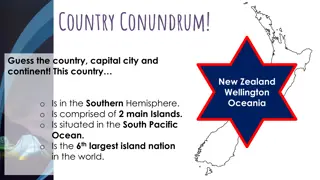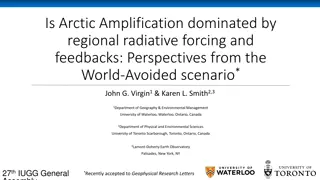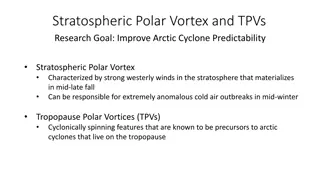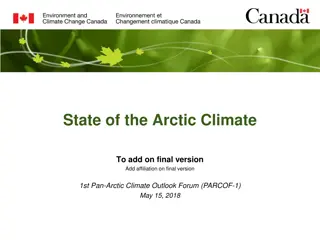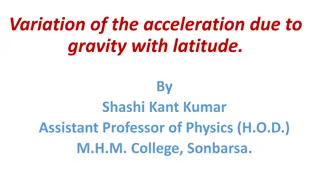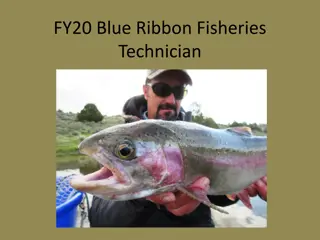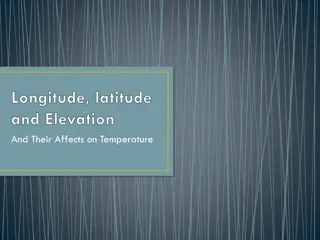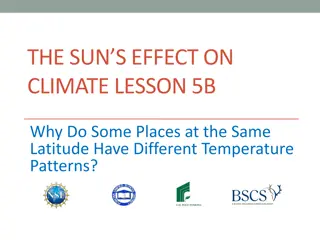Understanding Lower Latitude Drivers of Arctic Changes in the Blue-Action Project
Blue-Action WP2 focuses on assessing key influences and predictors of Arctic climate changes, emphasizing the importance of sustained observations, AMOC impact, and heat transport. The project involves 20 partners and around 40 scientists, aiming to study interannual to decadal heat anomalies affecting Arctic sea ice extent and atmosphere. Tasks include model-observation comparisons, analyzing ocean heat transport, and identifying predictors for Arctic sea ice variability.
Download Presentation

Please find below an Image/Link to download the presentation.
The content on the website is provided AS IS for your information and personal use only. It may not be sold, licensed, or shared on other websites without obtaining consent from the author. Download presentation by click this link. If you encounter any issues during the download, it is possible that the publisher has removed the file from their server.
E N D
Presentation Transcript
Blue-Action WP2 Lower latitude drivers of Arctic changes Lead: Karin Margretha H. Larsen, HAV Co-lead: Gerard McCarthy, NERC/NOC
WP2 Who are we? 20 partners (DMI, CNRS, GEOMAR, HAV, MEOPAR, MPI, MRI, MSS, UCAR, NERSC, NIOZ, NLeSC, NERC, SRSL, UHAM, UIB, UNIRES, UoS, UoW, WHOI) ~40 scientists Observers and modellers
What will we do? Key conclusions: The importance of the AMOC for the climate is paramount There is a pressing need for sustained observations of the AMOC and associated heat transport; The potential predictability of the AMOC and therefore of its climate impacts needs further study. Lower latitude drivers of Arctic changes
Interannual- to decadal-scale ocean heat anomalies associated with the northern limb of the AMOC propagate persistently toward the Arctic Ocean heat anomalies in the northern seas are reflected in regional sea ice extent and found to influence the atmosphere...
Three key predictors for internal low- frequency variability of summer Arctic sea ice extent are identified ... including both the Atlantic and Pacific ocean heat transport into the Arctic, as well as the atmosphere circulation.
WP2 Task 2.1 Assessment of key lower latitude influences on the Arctic and their simulation (NERC) D2.1 Model-observation and reanalyses comparison at key locations for heat transport to the Arctic (NERC) D2.2 Seasonal to decadal variability of the subpolar gyre (SAMS) D2.3 Processes and flow over the Iceland-Faroe Ridge (DMI) D2.4 Synthesis and dissemination of ocean and atmosphere heat transport to the Arctic (NLeSC)
WP2 Tasks 2.2 Pathways and interactions sustaining Arctic predictability (UiB) D2.5 Assessment of Oceanic anomalies of predictive potential (UiB) D2.6 Oceanic heat anomalies and Arctic sea-ice variability (CNRS) MS8 Assessment of heat transport and distribution in the high Arctic in eddy resolving model (CNRS) MS9 Coupled reanalysis of the Arctic climate (CNRS)
WP2 Tasks 2.3 Optimization and coordination of existing TMA systems, improved data delivery for predictions and identification of gaps (HAV) D2.7 Cost-benefit analysis of the RAPID and OSNAP arrays (GEOMAR) D2.8 Optimization of the GSR inflow arrays (HAV)
WP2 - Objectives Enhancing the predictive capacity beyond seasons Assessment of Oceanic anomalies of predictive potential Reanalyses to serve as input to WP4 (Enhancing the capacity of s2d prediction) Optimizing observational systems Near real time data access from TMAs (NACLIM, AtlantOS, NERC) Integrate New Earth Obs. to inflow arrays
WP2 Objectives (cont.) Reducing and evaluating the uncertainty in prediction systems Improve simulations of poleward flow Observations and newest reanalyses products to be compared with climate models Collaborate with the Copernicus Climate Change Service (C3S)
WP2 Observations/Data New Earth Obs. Univ. W. (+ Ber.Str.) GSR-TMAs Gliders (SAMS) OWS-M EEL OSNAP Argo Floats OVIDE RAPID
Models and Reanalyses Models: Coupled climate: HadGEM-Charisma, IPSL, CESM High res ocean-only: NEMO (1/24 ), a.o. Reanalyses: MERRA, ERA5, ERA20CM, ORAS5 NorCPM, IPSL (produced within Blue-Action)
Presentations tomorrow Heat transport to the Arctic and its impacts Gerard McCarthy Towards a new reanalysis with the IPSL climate model Juliette Mignot
WP2 Deliverables Lead D2.1 Model-observation and reanalyses comparison at key locations for heat transport to the Arctic NERC D2.2 Seasonal to decadal variability of the subpolar gyre SAMS D2.3 Processes and flow over the Iceland-Faroe Ridge DMI D2.4 Synthesis and dissemination of ocean and atmosphere heat transport to the Arctic NLeSC D2.5 Assessment of Oceanic anomalies of predictive potential UiB D2.6 Oceanic heat anomalies and Arctic sea-ice variability CNRS D2.7 Cost-benefit analysis of the RAPID and OSNAP arrays GEOMAR D2.8 Optimization of the GSR inflow arrays HAV
Milestone title WPs Lead Means of verification MS8 Assessment of heat transport and distribution in the high Arctic in eddy resolving model WP2, WP3 CNRS Identification of robust metrics MS9 Coupled reanalysis of the Arctic climate WP2, WP3, WP4 CNRS Two novel climate reanalyses made available to the project for evaluation (WP2), process analysis (WP3) and predictability studies (WP4)
